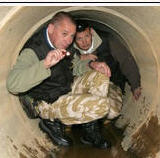Some academic research on child killers
The Complete Mystery of Madeleine McCann™ :: Latest News and Debate :: Debate Section - for purporting theories
Page 1 of 1 • Share
 Some academic research on child killers
Some academic research on child killers
Who Murders Children? The Latest Research Profiles Child Killers, Can it Help Detection?
OUR POLICE HAVE THIS IMFORMATION facts are facts
Child murder remains a rare crime, 5-6 per million of children aged from birth to fourteen years, twenty to forty homicides a year compared with between one to two hundred annually killed on the roads.
But despite its rarity, enigmatic patterns are emerging from the latest research, which can help track down perpetrators, and assist parents in protecting their families.
Forensic experts begin building a profile of the killer, just from the age of the victim. If a child of five or older goes missing and is feared dead, it is highly likely the perpetrator is someone outside the family.
A recent survey of a decade of consecutive child homicides in England, by Colin Pritchard and Tony Sayer from Bournemouth University, published in the 'British Journal of Social Work', established homicidal assailants of children younger than 5, are much more likely to come from within the same family.
The contrasting profiles of intra-familial as opposed to that of extra-familial killers are vital clues deployed by the police during a search.
For example, in the Pritchard and Sayer study entitled 'Exploring Potential 'Extra-Familial' Child Homicide Assailants in the UK and Estimating their Homicide Rate: Perception of Risk--The Need for Debate', none of the 'Extra-familial' assailants killer, For example, in the Pritchard and Sayer study entitled 'Exploring Potential 'Extra-Familial' Child Homicide Assailants in the UK and Estimating their Homicide Rate: Perception of Risk--The Need for Debate', none of the 'Extra-familial' assailants killed a child under five.
In contrast to this picture for 'extra-familial' killers, previous research confirms the majority of assailants in child murder, particularly those below 5, are in fact the victim's parents. Most are mothers, often suffering mental illnesses such as forms of post-natal psychosis, whilst all the natural fathers who killed their children, then committed suicide.
Of the five extra-familial killers investigated in Pritchard and Sayer's research, all were males aged nineteen to forty-two and had multiple past convictions. One was termed a Multi-Criminal-Child-Sex-Abuser while the remaining four were Violent-Multi-Criminal-Child-Sex-Abusers. Pritchard and Sayer argue this high level of previous criminality reflects chaotic backgrounds. Of the five 'Extra-familial' killers, four had some known previous contact with their victim, but were not in any type of 'familial' relationship.
Pritchard and Sayer emphasise 'Extra-familial' doesn't mean totally unknown to the victim - an absolute stranger, as in the completely random killing of Sarah Payne. Often, the child is familiar with their assailant. In the case of Ian Huntley who killed Jessica Chapman and Holly Wells, his partner being a teaching assistant at the school where he was a caretaker, meant he was trusted by children.
A study entitled 'Sexually Motivated Child Abduction Murders: Synthesis of the Literature and Case Illustration' by Kathleen Heide, Eric Beauregard and Wade Myers from the University of South Florida, and Simon Fraser University, British Columbia, confirms two main subsets of offenders. One group who have sexually sadistic urges are aroused and gratified by the suffering and the killing of young victims. But these are different from sex murderers who kill primarily to avoid apprehension, and not specifically for sadistic gratification.
Published in the academic journal 'Victims and Offenders' this US review also confirms the police can infer a lot about who committed the crime just from the age of the victim. When a child is younger than 5, the suspect (equally likely male or female) is most probably from within the same family, not motivated by molesting, and tends to kill using their hands. When the child is between the ages of 5 and 12, the suspect is most often male, a close friend or a stranger, sexually compulsive, killing using means such as strangling. Finally, if the child victim is between 13 and 17, the suspect is most likely to be a close friend or a stranger, sexually driven, killing with weapons.
Heide and colleagues also report on the most complete previous study of sexually motivated child abduction murders. Analysis of 621 cases representing 44 states across the USA showed that in 44% of the cases the victim was deceased within one hour post abduction. Within three hours, 74% of victims were dead. Fast action in missing children cases becomes vital because US data suggests there is typically a two hour delay with the initial missing child report.
Heide, Beauregard and Myers also report location patterns now play a crucial rule in the way forensic science is used to apprehend culprits. They report studies which conclude in the majority of cases (72%), the radius from body recovery site to murder scene is less than 200 feet. The distribution was different when it came to journey from the initial contact setting to the murder site: 31% travelled 0-199 feet, whereas 43% trekked 1.5-12 miles.
 Re: Some academic research on child killers
Re: Some academic research on child killers
Just taking statistics into account, although it is most likely that the parents would be involved in any disappearance of a child under 5, it is still possible in theory that there may have been an abductor.
However, if all the evidence given by the tapas group is true, then there was never the opportunity for someone to have abducted MM.
On the other hand, if some of the evidence given by the tapas group to the police is not true then there can only be two reasons for this,
either, they have something to hide in relation to her disappearance
or, they tried to make it appear as though they were checking more often than they were (if they did not know where MM was, then misleading the police could have put her life in danger)
However, if all the evidence given by the tapas group is true, then there was never the opportunity for someone to have abducted MM.
On the other hand, if some of the evidence given by the tapas group to the police is not true then there can only be two reasons for this,
either, they have something to hide in relation to her disappearance
or, they tried to make it appear as though they were checking more often than they were (if they did not know where MM was, then misleading the police could have put her life in danger)
____________________

suzyjohnson- Posts : 1209
Activity : 1542
Likes received : 271
Join date : 2013-03-04
 Another interesting study
Another interesting study
Who Murders Children? The Latest Research Profiles Child Killers, but Can it Help Detection?
Posted: 10/10/2012 11:24 BST Updated: 09/12/2012 10:12 GMT
Child murder remains a rare crime, 5-6 per million of children aged from birth to fourteen years, twenty to forty homicides a year compared with between one to two hundred annually killed on the roads.
But despite its rarity, enigmatic patterns are emerging from the latest research, which can help track down perpetrators, and assist parents in protecting their families.
Forensic experts begin building a profile of the killer, just from the age of the victim. If a child of five or older goes missing and is feared dead, it is highly likely the perpetrator is someone outside the family.
A recent survey of a decade of consecutive child homicides in England, by Colin Pritchard and Tony Sayer from Bournemouth University, published in the 'British Journal of Social Work', established homicidal assailants of children younger than 5, are much more likely to come from within the same family.
The contrasting profiles of intra-familial as opposed to that of extra-familial killers are vital clues deployed by the police during a search.
For example, in the Pritchard and Sayer study entitled 'Exploring Potential 'Extra-Familial' Child Homicide Assailants in the UK and Estimating their Homicide Rate: Perception of Risk--The Need for Debate', none of the 'Extra-familial' assailants killed a child under five.
In contrast to this picture for 'extra-familial' killers, previous research confirms the majority of assailants in child murder, particularly those below 5, are in fact the victim's parents. Most are mothers, often suffering mental illnesses such as forms of post-natal psychosis, whilst all the natural fathers who killed their children, then committed suicide.
Of the five extra-familial killers investigated in Pritchard and Sayer's research, all were males aged nineteen to forty-two and had multiple past convictions. One was termed a Multi-Criminal-Child-Sex-Abuser while the remaining four were Violent-Multi-Criminal-Child-Sex-Abusers. Pritchard and Sayer argue this high level of previous criminality reflects chaotic backgrounds. Of the five 'Extra-familial' killers, four had some known previous contact with their victim, but were not in any type of 'familial' relationship.
Pritchard and Sayer emphasise 'Extra-familial' doesn't mean totally unknown to the victim - an absolute stranger, as in the completely random killing of Sarah Payne. Often, the child is familiar with their assailant. In the case of Ian Huntley who killed Jessica Chapman and Holly Wells, his partner being a teaching assistant at the school where he was a caretaker, meant he was trusted by children.
A study entitled 'Sexually Motivated Child Abduction Murders: Synthesis of the Literature and Case Illustration' by Kathleen Heide, Eric Beauregard and Wade Myers from the University of South Florida, and Simon Fraser University, British Columbia, confirms two main subsets of offenders. One group who have sexually sadistic urges are aroused and gratified by the suffering and the killing of young victims. But these are different from sex murderers who kill primarily to avoid apprehension, and not specifically for sadistic gratification.
Published in the academic journal 'Victims and Offenders' this US review also confirms the police can infer a lot about who committed the crime just from the age of the victim. When a child is younger than 5, the suspect (equally likely male or female) is most probably from within the same family, not motivated by molesting, and tends to kill using their hands. When the child is between the ages of 5 and 12, the suspect is most often male, a close friend or a stranger, sexually compulsive, killing using means such as strangling. Finally, if the child victim is between 13 and 17, the suspect is most likely to be a close friend or a stranger, sexually driven, killing with weapons.
Heide and colleagues also report on the most complete previous study of sexually motivated child abduction murders. Analysis of 621 cases representing 44 states across the USA showed that in 44% of the cases the victim was deceased within one hour post abduction. Within three hours, 74% of victims were dead. Fast action in missing children cases becomes vital because US data suggests there is typically a two hour delay with the initial missing child report.
Heide, Beauregard and Myers also report location patterns now play a crucial rule in the way forensic science is used to apprehend culprits. They report studies which conclude in the majority of cases (72%), the radius from body recovery site to murder scene is less than 200 feet. The distribution was different when it came to journey from the initial contact setting to the murder site: 31% travelled 0-199 feet, whereas 43% trekked 1.5-12 miles.
Christine Gregoire an Attorney General from the State of Washington in the USA reports the killers are usually at the initial contact site for legitimate reasons. They either lived in the area or were engaging in some routine. She also reports most child abduction murders are opportunistic. Only in 14 percent of cases was the victim picked out because of some physical characteristic. The initial contact site is within 1/4 mile of the victim's last known location in 80% of cases.
Gregoire explains in her paper entitled 'Case Management for Missing Children Homicide Investigation' that in only 9% of cases is the body openly placed to facilitate discovery. She therefore wants searchers placed at intervals approximately equal to the height of the victim.
In our clinical experience, these geographical patterns contribute enormously to the emotional distress for police involved in these cases. They always know time is fast running out, yet they may have extensive areas to search. But eventually, most frequently, the child is still discovered close to home.
Gregoire argues parents need to be most aware children are not immune from abduction simply because they are playing near where they live. In fact, US data suggests well over half of abductions that led to murder took place within three city blocks of the victim's home and approximately one-third within one-half block.
Also, given how common child battering is, according to the authors of the most recent and definitive study on the subject - entitled 'Who Kills Children? Re-Examining the Evidence' just published in the 'British Journal of Social Work', it remains an enigma just how rare child homicide remains.
The authors of the research, Colin Pritchard, Jill Davey and Richard Williams from Bournemouth University, point out it's estimated eleven children per day are seen in hospital casualty departments up and down this country with suspected physical child abuse. So there is only one death to 188 possible abuse-related A&E admissions, of under four-year-olds each year. Pritchard and colleagues argue these statistics indicate the exceptional nature of those who actually kill children.
Heide, Beauregard and Myers describe a personality profile of a typical extra-familial perpetrator - shy, anxious, reserved, feeling inferior; taking refuge in fantasy, where they become omnipotent and powerful. But the more they take flight into the imagination, the more real it becomes. This imaginary world gets so familiar, it's inevitably enacted.
As a result of this secret inner world, family, neighbours, and friends never guess who is capable of such a crime.
Posted: 10/10/2012 11:24 BST Updated: 09/12/2012 10:12 GMT
Child murder remains a rare crime, 5-6 per million of children aged from birth to fourteen years, twenty to forty homicides a year compared with between one to two hundred annually killed on the roads.
But despite its rarity, enigmatic patterns are emerging from the latest research, which can help track down perpetrators, and assist parents in protecting their families.
Forensic experts begin building a profile of the killer, just from the age of the victim. If a child of five or older goes missing and is feared dead, it is highly likely the perpetrator is someone outside the family.
A recent survey of a decade of consecutive child homicides in England, by Colin Pritchard and Tony Sayer from Bournemouth University, published in the 'British Journal of Social Work', established homicidal assailants of children younger than 5, are much more likely to come from within the same family.
The contrasting profiles of intra-familial as opposed to that of extra-familial killers are vital clues deployed by the police during a search.
For example, in the Pritchard and Sayer study entitled 'Exploring Potential 'Extra-Familial' Child Homicide Assailants in the UK and Estimating their Homicide Rate: Perception of Risk--The Need for Debate', none of the 'Extra-familial' assailants killed a child under five.
In contrast to this picture for 'extra-familial' killers, previous research confirms the majority of assailants in child murder, particularly those below 5, are in fact the victim's parents. Most are mothers, often suffering mental illnesses such as forms of post-natal psychosis, whilst all the natural fathers who killed their children, then committed suicide.
Of the five extra-familial killers investigated in Pritchard and Sayer's research, all were males aged nineteen to forty-two and had multiple past convictions. One was termed a Multi-Criminal-Child-Sex-Abuser while the remaining four were Violent-Multi-Criminal-Child-Sex-Abusers. Pritchard and Sayer argue this high level of previous criminality reflects chaotic backgrounds. Of the five 'Extra-familial' killers, four had some known previous contact with their victim, but were not in any type of 'familial' relationship.
Pritchard and Sayer emphasise 'Extra-familial' doesn't mean totally unknown to the victim - an absolute stranger, as in the completely random killing of Sarah Payne. Often, the child is familiar with their assailant. In the case of Ian Huntley who killed Jessica Chapman and Holly Wells, his partner being a teaching assistant at the school where he was a caretaker, meant he was trusted by children.
A study entitled 'Sexually Motivated Child Abduction Murders: Synthesis of the Literature and Case Illustration' by Kathleen Heide, Eric Beauregard and Wade Myers from the University of South Florida, and Simon Fraser University, British Columbia, confirms two main subsets of offenders. One group who have sexually sadistic urges are aroused and gratified by the suffering and the killing of young victims. But these are different from sex murderers who kill primarily to avoid apprehension, and not specifically for sadistic gratification.
Published in the academic journal 'Victims and Offenders' this US review also confirms the police can infer a lot about who committed the crime just from the age of the victim. When a child is younger than 5, the suspect (equally likely male or female) is most probably from within the same family, not motivated by molesting, and tends to kill using their hands. When the child is between the ages of 5 and 12, the suspect is most often male, a close friend or a stranger, sexually compulsive, killing using means such as strangling. Finally, if the child victim is between 13 and 17, the suspect is most likely to be a close friend or a stranger, sexually driven, killing with weapons.
Heide and colleagues also report on the most complete previous study of sexually motivated child abduction murders. Analysis of 621 cases representing 44 states across the USA showed that in 44% of the cases the victim was deceased within one hour post abduction. Within three hours, 74% of victims were dead. Fast action in missing children cases becomes vital because US data suggests there is typically a two hour delay with the initial missing child report.
Heide, Beauregard and Myers also report location patterns now play a crucial rule in the way forensic science is used to apprehend culprits. They report studies which conclude in the majority of cases (72%), the radius from body recovery site to murder scene is less than 200 feet. The distribution was different when it came to journey from the initial contact setting to the murder site: 31% travelled 0-199 feet, whereas 43% trekked 1.5-12 miles.
Christine Gregoire an Attorney General from the State of Washington in the USA reports the killers are usually at the initial contact site for legitimate reasons. They either lived in the area or were engaging in some routine. She also reports most child abduction murders are opportunistic. Only in 14 percent of cases was the victim picked out because of some physical characteristic. The initial contact site is within 1/4 mile of the victim's last known location in 80% of cases.
Gregoire explains in her paper entitled 'Case Management for Missing Children Homicide Investigation' that in only 9% of cases is the body openly placed to facilitate discovery. She therefore wants searchers placed at intervals approximately equal to the height of the victim.
In our clinical experience, these geographical patterns contribute enormously to the emotional distress for police involved in these cases. They always know time is fast running out, yet they may have extensive areas to search. But eventually, most frequently, the child is still discovered close to home.
Gregoire argues parents need to be most aware children are not immune from abduction simply because they are playing near where they live. In fact, US data suggests well over half of abductions that led to murder took place within three city blocks of the victim's home and approximately one-third within one-half block.
Also, given how common child battering is, according to the authors of the most recent and definitive study on the subject - entitled 'Who Kills Children? Re-Examining the Evidence' just published in the 'British Journal of Social Work', it remains an enigma just how rare child homicide remains.
The authors of the research, Colin Pritchard, Jill Davey and Richard Williams from Bournemouth University, point out it's estimated eleven children per day are seen in hospital casualty departments up and down this country with suspected physical child abuse. So there is only one death to 188 possible abuse-related A&E admissions, of under four-year-olds each year. Pritchard and colleagues argue these statistics indicate the exceptional nature of those who actually kill children.
Heide, Beauregard and Myers describe a personality profile of a typical extra-familial perpetrator - shy, anxious, reserved, feeling inferior; taking refuge in fantasy, where they become omnipotent and powerful. But the more they take flight into the imagination, the more real it becomes. This imaginary world gets so familiar, it's inevitably enacted.
As a result of this secret inner world, family, neighbours, and friends never guess who is capable of such a crime.
 Re: Some academic research on child killers
Re: Some academic research on child killers
when I was at infants school one of the boys in the year above was found dead in the local canal . To this day anybody local who remembers the case is convinced it was the father though in the end no charges were brought and it was put down as a tragic accident .
I think however had this happened today the outcome would have been very different .
It was obvious that this boy was being abused and his sister who was in my year . A few weeks before he died he had turned up at school in a wooley hat as his dad had shaved all his hair off and painted his head purple because he had, had head lice . Both he and his sister were always covered in bruises , they looked like waifs and strays in need of a good clean and food in their bellies . Nobody really had much money at the time but even then they stood out as being uncared for , their clothes were no better than rags .
Whenever the dad came into school I was terrified he was quite a brussen man , he was also a drunk and violent . He was a big bloke and seemed to fill the room and when he shouted his voice would boom down the corridor .
He died a few years ago taking whatever secrets he held to the grave with him .
Over the last few years I have often wondered with the advances in science and also the discovery of dna if the whole sad affair would have indeed had a different outcome had it happened today .
Thats what I find so strange in the Mccann case the lack of dna ? it just makes no sense whatsoever .
The article and statistics you have posted Petermac are interesting however I do wonder just how accurate they are and infact just how many parents and strangers do infact get away with murder and the death of the poor child instead of recorded as murder is actually put down as a tragic accident or an open verdict .
there is also the other side of the coin how many are accused of murder when infact the child has died of a rare condition .
I think however had this happened today the outcome would have been very different .
It was obvious that this boy was being abused and his sister who was in my year . A few weeks before he died he had turned up at school in a wooley hat as his dad had shaved all his hair off and painted his head purple because he had, had head lice . Both he and his sister were always covered in bruises , they looked like waifs and strays in need of a good clean and food in their bellies . Nobody really had much money at the time but even then they stood out as being uncared for , their clothes were no better than rags .
Whenever the dad came into school I was terrified he was quite a brussen man , he was also a drunk and violent . He was a big bloke and seemed to fill the room and when he shouted his voice would boom down the corridor .
He died a few years ago taking whatever secrets he held to the grave with him .
Over the last few years I have often wondered with the advances in science and also the discovery of dna if the whole sad affair would have indeed had a different outcome had it happened today .
Thats what I find so strange in the Mccann case the lack of dna ? it just makes no sense whatsoever .
The article and statistics you have posted Petermac are interesting however I do wonder just how accurate they are and infact just how many parents and strangers do infact get away with murder and the death of the poor child instead of recorded as murder is actually put down as a tragic accident or an open verdict .
there is also the other side of the coin how many are accused of murder when infact the child has died of a rare condition .

frost- Posts : 210
Activity : 222
Likes received : 0
Join date : 2014-02-27
The Complete Mystery of Madeleine McCann™ :: Latest News and Debate :: Debate Section - for purporting theories
Page 1 of 1
Permissions in this forum:
You cannot reply to topics in this forum
































